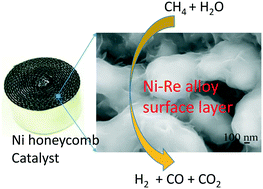High cell density Ni monolithic catalysts coated with a series of Ni–Re bimetallic surface layers (Re 0–38 at%) were synthesized and examined for application in methane steam reforming (MSR) under a steam-to-carbon ratio of 1.36 and a gas hourly space velocity of 6400 h−1 in the temperature range of 773–1173 K. The influence of mass and heat transport was verified to be minor below 973 K under the present experimental conditions. The catalytic activities of the Ni monolithic catalysts were effectively improved in the presence of a Ni–Re bimetallic surface layer coating, and the stability in terms of the catalyst activity was significantly enhanced below 973 K upon increasing the Re content to >24 at%. The Ni–Re surface layer was analyzed by using in situ X-ray absorption fine structure spectroscopy, synchrotron radiation X-ray diffraction, scanning electron microscopy, and density functional theory calculations. These results revealed that a Ni–Re alloy consisting of a Ni(Re) solid solution phase and a Re phase was formed during hydrogen pre-reduction and the subsequent MSR reaction. The Re atoms in the Ni–Re alloy promoted hydrogen adsorption on the surface, thereby suppressing the oxidation of the surface Ni atoms during MSR, and enhancing the stability of the monolithic catalysts.
